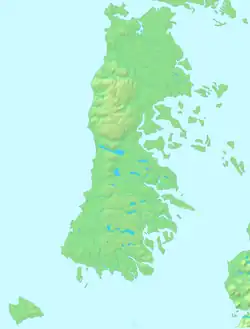Native name: kawkawé, kawkagwé | |
|---|---|
| Geography | |
| Location | Los Lagos Region |
| Coordinates | 42°8′42″S 73°24′17″W / 42.14500°S 73.40472°W |
| Adjacent to | Caucahue Channel, Pacific Ocean |
| Total islands | 1 |
| Administration | |
| Demographics | |
| Population | 354 (2017)[1] |
| Ethnic groups | Caucahue descendants, Mapuche people, Veliche people |
Caucahué is an island located in the Caucahué Channel, Chiloé Province, Los Lagos Region (Region of the Lakes), Commune of Quemchi in southern Chile. It has a population of 354 according to the 2017 census,[1] this is almost a halving relative to the 638 inhabitants recorded in the 2001 Chilean census.[2] The island supplies the city of Quemchi with farm and sea products.
The name Cahucahué comes from Mapudungun (the Mapuche language), and means “place of many seagulls”, from the words káwka or kawkaw, meaning "big seagull", and we, meaning place"'.[3]
Caucahue Island used to be home to the now-extinct Caucahue people. The Caucahue were one of the canoe-going peoples that lived in the southernmost regions of Chile. They were hunter gatherers and made good use of the sea's resources, living off sea food, seaweed and minor game that they found on the island and its surrounding areas. Along with farming, today's inhabitants of the island still use the sea as a livelihood, and sell their seafood and farm produce at the Quemchi free market located right across the channel on Chiloé Island.
The island is divided into four parts: Queler, Morro Lobos Bajo, Morro Lobos Alto and Quinterquén. It has four schools, each with one teacher: "Escuela Queler", "Escuela Caucahué", "Escuela Morro Lobos" and "Escuela Quinterquén".[4] It is connected to the mainland via the town of Quemchi. A daily boat service runs from Quemchi to the island and private boats are also available for the 20 minute trip.
Caucahue's natural vegetation is Valdivian temperate rain forest and it has a temperate climate with constant rain all year round.
References
- 1 2 División político administrativa y censal Región de Los Lagos (PDF) (in Spanish). Departamento de Geografía, Instituto Nacional de Estadísticas. 2019. p. 4. Retrieved February 28, 2021.
- ↑ 2001 Chilean census IInstituto Nacional de Estadisticas Chile, report, page 169, retrieved on June 15, 2015
- ↑ TOPONIMIA INDIGENA DE CHILE NOMBRES DE LUGAR INDIGENAS DE OSORNO, LLANQUIHUE Y CHILOE (CHILE), Valdivia, Dirección de Investigación - UNIPRINT register Nº 67.806, Santiago de Chile, Carlos Ramírez Sánchez, retrieved on June 16, 2015
- ↑ wikimapia datasheet wikimapia retrieved on June 16, 2015
